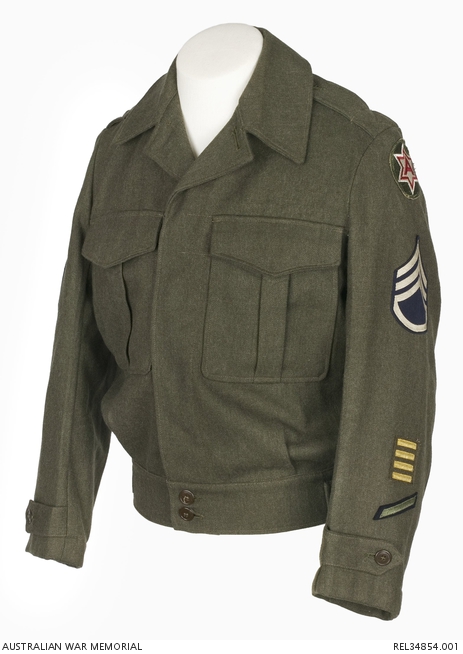| Places | |
|---|---|
| Accession Number | REL34854.001 |
| Collection type | Heraldry |
| Object type | Uniform |
| Physical description | Embroidery cotton thread, Plastic, Wool |
| Maker |
Unknown |
| Place made | Australia |
| Date made | 1944 |
| Conflict |
Second World War, 1939-1945 |
Battledress blouse : Staff Sergeant M H Rechnitz, 168 United States Field Artillery Regiment

United States Army officers olive drab wool battledress blouse with fold down collar and button down shoulder straps. The blouse has two pleated patch breast pockets with pointed flaps and concealed plastic buttons. The sleeves have the rank insignia for staff sergeant attached. On the left shoulder is sewn an embroidered patch for the United States 6th Army. On the lower cuff of this sleeve are four gold embroidered horizontal overseas service stripes with a green embroidered military service stripe below at an angle of 45 degrees.
The blouse is fastened down the centre by five concealed tan plastic buttons and a dark brown plastic button at the throat. The waist is gathered and fastened by two dark brown plastic buttons and a self fabric belt. The cuffs fasten with a single plastic button. A blue printed manufacturer's label is sewn inside the right hand side of the blouse which reads, 'N425 1944. SIZE 36R Made in Australia'. The blouse is unlined.
Associated with the service of 20840558 Staff Sergeant Max Heinz Rechnitz. Rechnitz was born in Vienna, Austria on 10 July 1919 and migrated to the United States before the outbreak of the Second World War. He enlisted with the Colorado National Guard in Golden, Colorado in February 1941 and was taken on strength by the 168th Field Artillery Regiment. He was posted to Camp Forest, Tullahoma, Tennessee for initial training before being transferred first to Fort Ord, Monterey, California; then Camp San Luis Obispo, San Luis Obispo California and finally to Camp Roberts, San Miguel, California. Rechnitz remained at Camp Roberts until late 1943, when his unit was sent to Sydney, Australia.
After waiting a month for equipment to arrive from the United States, 168 Field Artillery, now under the control of the US Sixth Army, was posted to Goodenough Island, as part of Operation Cartwheel. Operation Cartwheel was launched to isolate and neutralise the major Japanese base at Rabaul. Allied forces were to advance along the northeast coast of New Guinea and occupy nearby islands. As part of this campaign Rechnitz was landed at Biak Island, then at Hollandia.
Rechnitz was stationed in Hollandia until September 1944 when the Sixth Army was released from operations in New Guinea in preparation for the invasion of Luzon in the Philippines. Landing near the capital city, Baguio on 9 January 1945 the Sixth Army fought south for several months until they met up with the Eighth Army advancing north from Manila. The Sixth Army then continued to clear the country north of Luzon until the end of the war.
After the Japanese surrender Rechnitz returned to the United States in October and was discharged from the Army the following month.
Related information
Conflicts
Places
Subjects
People
Related Objects
- Japanese Invasion Money Philippines 1000 pesos notes : Staff Sergeant M H Rechnitz, 168 United States Field Artillery Regiment
- Japanese Invasion Money Philippines 1 centavo notes : Staff Sergeant M H Rechnitz, 168 United States Field Artillery Regiment
- Japanese Invasion Money Philippines 1 centavo notes : Staff Sergeant M H Rechnitz, 168 United States Field Artillery Regiment
- US Army campaign hat : Staff Sergeant M H Rechnitz, 168 United States Field Artillery Regiment
- Forage cap : Staff Sergeant M H Rechnitz, 168 United States Field Artillery Regiment
- Neck tie : Staff Sergeant M H Rechnitz, 168 United States Field Artillery Regiment
- Long sleeved combat shirt : Staff Sergeant M H Rechnitz, 168 United States Field Artillery Regiment
- Long sleeved shirt : Staff Sergeant M H Rechnitz, 168 United States Field Artillery Regiment
- Battledress trousers : Staff Sergeant M H Rechnitz, 168 United States Field Artillery Regiment
- Pair of Japanese ammunition pouches : Staff Sergeant M H Rechnitz, 168 United States Field Artillery Regiment